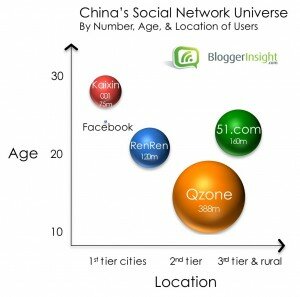Originally posted at VentureBeat
There is no single dominant network, no Facebook for all of China. The actual Facebook.com is blocked by government censors (Chinese sites all obediently and quickly remove “objectionable” content). No single social network will conquer the China market in the immediate future, least of all a foreign one. 
Instead, there is fierce competition between the top four:
-
RenRen (formerly Xiaonei) copied the Facebook model: it started with students and has since opened to all.
-
Kaixin001 attracted white-collar office workers by focusing on fun, addictive social games.
-
Qzone gained young teens and rural users via cross-promotional traffic from QQ Messenger.
-
51.com started strong in lower tier cities, but growth has since slowed.
This post will assess market share, profile the top four, and boldly predict the future.
 Benjamin Joffe of +8* posted his complete commentary "Sorting Failure From Success in Social Networking | The Tencent Case" in response to our latest piece "3 Reasons Why Tencent’s Qzone is a Failure." Thanks to Benjamin Joffe for posting this!
Benjamin Joffe of +8* posted his complete commentary "Sorting Failure From Success in Social Networking | The Tencent Case" in response to our latest piece "3 Reasons Why Tencent’s Qzone is a Failure." Thanks to Benjamin Joffe for posting this!
While the overall success of Tencent as a company is pretty obvious, our friends from Blogger Insight took the specific case of Tencent’s SNS properties Qzone, QQ Campus and Xiaoyou to see how they were performing. Their conclusion is that Tencent pretty much failed at SNS. Our take is less conclusive. Read the full piece here.

Originally posted at VentureBeat
Tencent, a Chinese internet giant in instant messaging, social networks, and mobile, posted $1.8 billion in 2009 revenues, an increase of 74% from a year ago. For the record, that’s about three times Facebook’s in 2009 revenues.
Tencent’s flagship product, QQ Messenger (with a cute penguin logo), is the first introduction to the internet for most Chinese teens. It claims a whopping 523 million active users. Tencent then cross-promotes its other online offerings: QQ Show, QQ Game, QQ Music, QQ Pets, and its social network, Qzone.
Tencent is the undisputed world leader in micropayments. Each QQ service is connected to a “diamond membership” of a different color, that offers free and exclusive virtual goods. For instance, the “red diamond” membership helps you dress up your avatar for face-offs against other online fashionistas in QQ Show. About 10% of Tencent’s active users pay for such memberships, which cost around $1.50 per month. Over 75% of total revenues come from these “internet value-added services,” which grew 94% in 2009.

Qzone, “the largest social network in China,” and Tencent’s other SNS (QQ Campus and Xiaoyou), are failures for three reasons:
- Squandered Opportunity: Chinese internet giant Tencent was enviously positioned to dominate social networking, but blew its chance. QQ Campus failed. Xiaoyou is far behind the competition. Qzone does not reach any new demographics.
- The Site’s Design and Features are Lousy: The Qzone website is an unintuitive eyesore. Its applications are of poor quality and frequently inaccessible.
- Is Qzone Really No. 1? Tencent’s claim of 305 million active users is highly suspect; even its classification as an SNS is questionable. Its competitors are encroaching upon its core user base of young teens.
Does this mean Tencent will soon collapse? Absolutely not.
High-Margin Virtual Goods are Generating Very Real Profits
 Chinese technology companies have a reputation for lacking innovation and original products. Yet upon closer inspection the industry is brimming with ideas. Despite the fact that Taobao resembles eBay, Baidu searches like Google, and RenRen looks very similar to Facebook, these businesses are not simply knockoffs. The “Copy-to-China” label grossly underestimates the power and ingenuity of China’s internet ventures.
Chinese technology companies have a reputation for lacking innovation and original products. Yet upon closer inspection the industry is brimming with ideas. Despite the fact that Taobao resembles eBay, Baidu searches like Google, and RenRen looks very similar to Facebook, these businesses are not simply knockoffs. The “Copy-to-China” label grossly underestimates the power and ingenuity of China’s internet ventures.
Identical Western replicas do not work (there is a reason why no large multinational internet business is a leader here). Instead, local companies are innovating to serve the Chinese market better, creating products and services that appeal to the needs of the consumer. This is also true of other Asian markets, and the region is now a global leader in virtual goods. So much so that the businesses in Silicon Valley and elsewhere are starting to take notice.
For the unbelievers, there are enticing examples of the rewards to be had. Internet heavyweight Tencent recorded revenues of USD 1 billion, at a profit margin above 40 per cent, by selling virtual goods across its multiple online platforms for RMB 10 (RMB 1 = approx. USD 0.14) at a time. Home to China’s most popular instant messenger QQ, Q-Zone social network, and related game sites, it is one of a number of domestic internet sites making a very real profit from something “virtual”.
 Chinese technology companies have a reputation for lacking innovation and original products. Yet upon closer inspection the industry is brimming with ideas. Despite the fact that Taobao resembles eBay, Baidu searches like Google, and RenRen looks very similar to Facebook, these businesses are not simply knockoffs. The “Copy-to-China” label grossly underestimates the power and ingenuity of China’s internet ventures.
Chinese technology companies have a reputation for lacking innovation and original products. Yet upon closer inspection the industry is brimming with ideas. Despite the fact that Taobao resembles eBay, Baidu searches like Google, and RenRen looks very similar to Facebook, these businesses are not simply knockoffs. The “Copy-to-China” label grossly underestimates the power and ingenuity of China’s internet ventures.


